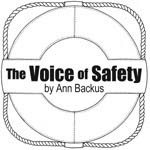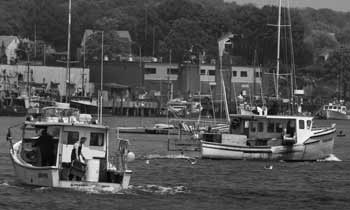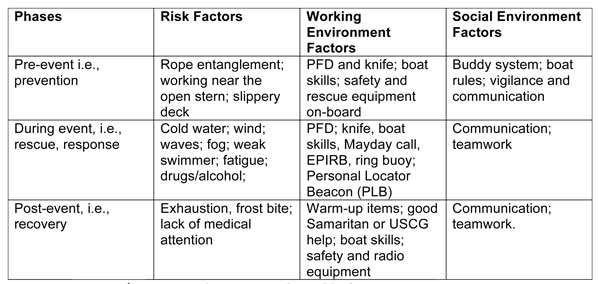Open Stern
Can we control the hazard?
Ann Backus, MS

Whether in Gloucester, MA, Friendship, ME, or elsewhere along the East Coast, open stern lobster boats are in evidence. This is the season for off-shore lobstering, rope lengths are longer per trap and generally there are more traps per trawl. A ten trap trawl, for example, is much more easily managed in an open stern boat than in a closed boat. All you have to do is push one trap and the remaining traps slip into the water in turn.
I remember a trip out of Kittery years ago in an open stern boat. The reason for the trip was not to experience an open stern, but to check-out a rope locker in action. The captain had retrofitted a rope locker below his deck on the starboard side that allowed the trap rope to fall into a below-deck space that ran nearly the length of the boat. He was extremely satisfied with this rope locker because it kept the multiple fathoms of rope away from his feet, therefore providing him some protection from entanglement in trap rope.

Gloucester Harbor, MA The open stern lobster boat began to be used in the 1980’s on offshore lobster boats that fished multi-trap trawls. They are now more common on inshore lobster boats as well. Earl Dotter photo
Most fishermen have a great respect for trawl lines. Some, such as the Kittery captain, even attribute human qualities to rope – has a mind of its own – he says. Rope responds to being kicked and shoved by developing kinks and tangles, while leaving it alone in a rope locker seems to result in an easy, tangle-free pay-out.
So here is the first point: Open stern boats present a hazard that traditional boats don’t have. If a fisherman becomes entangled in trap rope, he is not pinned against the transom, but is likely pulled into the water and down with the traps. Not a good situation, for sure.
Safe Practice
What then, constitutes best or safe practice in an open stern boat? First, having two crew on board is smart, BUT the sternman as well as the captain need to know how to operate the boat, execute a successful man overboard maneuver, and make a MAY DAY call. These skills must be practiced so that they are second-nature because, as trainers the world-over tell us, quick, deliberate action is imperative in a traumatic situation.
And…of course, you knew I was going to get to this—wearing a Personal Floatation Device—PFD, improves the chances of a safe recovery! There are many styles available now that are more comfortable to work in. Some, with a hydrostatically released CO2 cartridge, are not bulky. Some oil skins have embedded PFDs. At the Fishermen’s Forum, March 2-4, 2017 in Rockport, ME, check out the variety of PFDs at the Northeast Center for Occupational Safety and Health vendor booth and attend their presentation “Giving Safety a Competitive Advantage” to learn about their PFD evaluation study. (See the article by the same name in Fishermen’s Voice, February 2017, p. 7.)
Other response-related items to have at hand and be able to use include a ring-buoy to toss; a length of rope to tie to the ring buoy, if the situation dictates; a knife clipped to oil-skins, and an EPIRB. By the way, where are the ring buoy and the EPIRB mounted on the boat pictured above?
Consider a GPS-enabled 406 Personal Locator Beacon (PLB) – essentially an EPIRB for personal use. For a few hundred dollars, a Personal Locator Beacon is a great investment. Should wind and waves carry a man-overboard away from the boat, a PLB will provide the GPS coordinates the USCG needs in order to be able locate the individual. As with the EPIRB, the PLB must be registered with NOAA.
Prevention, Rescue/Response and Recovery in the Haddon’s Matrix Format
Rescue Accomplished
Once back on-board, the victim is going to need attention. A warm-up bag could be a good idea. [Wives and friends, if you are reading this, here is an idea for you.] Recycle your old sports bag with a towel, large blanket, hand-warmer packets, hat, scarf, mittens and old wool socks, tea bags and whatever else you think important.
Below is a table, adapted from a template called Haddon’s Matrix which is used as tool for analyzing a serious event after it happens. I set this one up to help us analyze a potential event before it happens and to enable us to think about the three phases of an event in terms of prevention, rescue/response, and recovery. How each phase is handled will determine the outcome of the event.
In conclusion, open stern boats, whether commercial fishing or patrol boats, present additional risks to crew. The captain and crew should give some thought to how to reduce risks and prepare for rescue and recovery should an event occur.
A concept called the Hierarchy of Controls can help us see the relative strengths of hazard controls with respect to open stern boats from the most effective to least effective ways to control a hazard or risk.
Elimination (of the hazard): A closed stern with transom.
Substitution (of the hazard): An electronic vane or swinging transom that opens to release the traps
Engineering Controls: Rope locker, EPIRB, radio Mayday call
Administrative Controls: Boat rules/buddy system, boat skills, vigilance, communication
Personal Protective Equipment: PFD, PLB, knife
Clearly, this is a system, so if the hazard/risk cannot be eliminated or a safer process substituted, then the next levels down in the Hierarchy of Controls must be engaged to control the hazard or reduce the risk. The controls in the list are not mutually exclusive; they should be used together to be mutually reinforcing. If a hazard exists, engineering, administrative and PPE controls must work together.
See you at the Fishermen’s Forum. Please stop by the Harvard booth to see what raffle idea I have come up with. Perhaps you could win something mentioned in this article!
Ann Backus, MS is an Instructor in Occupational Health at Harvard School of Public Health, 665 Huntington Ave., Boston MA 02115, 617-432-3327, abackus@hohp.harvard.edu.

